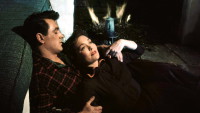
Newsletter June 2016
This year, 10 June marked the thirty-fourth anniversary of Rainer Werner Fassbinder’s death, and the film critic John Patterson used this occasion to write an appreciation of the director, which was printed in the Guardian. In his article, Patterson speaks of how shaken he was as a young movie buff by the news of the director’s death. For Patterson, Fassbinder’s death coincided with the end of a golden era in European film that forged an alternative to commercial cinema: “These were cinema movements that answered back: against the past, against father figures and the vapid, kitschy films they made; against monolithic Hollywood, seen as exploitative and invasive against [..] [Russian studio] Mosfilm and its numbskull apparatchiks; against tweeness, quaintness; against ‘entertainment’ and consolation; against formal timidity.” The complete article can be read at: https://www.theguardian.com/film/2016/jun/13/a-tribute-to-rw-fassbinder-cinemas-fierce-contrarian
The opposition between artistic and commercial cinema that Patterson refers to several times in his article is not unproblematic. Although Fassbinder himself repeatedly criticized the mendacity of Hollywood, he was also an admirer of directors such as Howard Hawks, Michael Curtiz, Nicholas Ray and Raoul Walsh – as was recently evident in a season of his favorite films screened at New York’s Metrograph cinema (http://metrograph.com/series/series/13/fassbinders-top-10).
RWF was of course particularly fond of the films of Douglas Sirk, who often had to deal with criticism that he only made sentimental films for women. Sirk’s masterful direction and the explosive force of his works were largely overlooked by contemporary critics. Fassbinder discovered Sirk’s work at a retrospective in Munich and his film FEAR EATS THE SOUL is loosely based on Sirk’s ALL THAT HEAVEN ALLOWS (on which Todd Haynes, an admirer of Fassbinder, based his film FAR FROM HEAVEN.) Between 8 July and 18 September, Berlin’s Zeughauskino is screening the bulk of Sirk’s work in 35 mm. The range covered extends from the somber Heimat films and light musical comedies made in Germany during the 1930s to the well-known American melodramas of the 1950s. A supplementary program focuses on Sirk’s work at Munich’s University of Film and Television in the late 1970s, where his work with students produced three cinematic exercises based on the work of Tennessee Williams, including the short film “Bourbon Street Blues,” in which Fassbinder appears as an actor. The complete program of films being shown in this season of Sirk is available at: http://www.dhm.de/zeughauskino/filmreihen/douglas-sirk.html
One of Fassbinder’s own films is currently featuring in an unusual context at Berlin’s Volksbühne. Two weeks ago the theater premiered Frank Castorf’s five-hour production “Die Kabale der Scheinheiligen. Das Leben des Herrn de Molière” (The Cabal of Hypocrites. The Life of Mister Molière). The production not only draws on motifs in the work of Michail Bulgakov, Pierre Corneille, Molière und Jean Racine but also reenacts scenes from the film BEWARE OF A HOLY WHORE, with lead actor Alexander Scheer providing a choleric Fassbinder imitation. Prior to the summer break, the production can be seen on 25 June and on 1 and 9 July. Tickets are available at: http://www.volksbuehne-berlin.de/praxis/die_kabale_der_scheinheiligen_das_leben_des_herrn_moliere/?id_datum=10418
Some weeks ago, author Janelle Okwodu discussed the influence of Fassbinder’s films on the fashion world in an article for Vogue. Particularly relevant in this respect are collections by Miuccia Prada, Max Mara and Kai Kühne, which refer in aesthetic terms to THE MARRIAGE OF MARIA BRAUN, LOLA, THE BITTER TEARS OF PETRA VON KANT and QUERELLE. The article is available at: http://www.vogue.com/13435429/rainer-werner-fassbinder-fashion-influence-documentary/. Unfortunately the author does not refer to the costume and makeup designers who worked on the films, and we would therefore like to take this opportunity to point to the achievements of Barbara Baum, Monika Jacobs, Egon Strasser and Maja Lemcke as well as Edwin Erfmann, Hedy Polensky, Gerhard Nemetz, Ingrid Massmann, Peter Müller, Margarethe Ullmann and Anni Nöbau.
Berlin is currently offering an opportunity to observe fascinating parallels between Fassbinder’s work and that of young artists. Parallel to the Berlin Biennale, the contemporary-art collector Julia Stoschek has established a branch of her Düsseldorf gallery in Leipziger Strasse, which is showing the exhibition “Welt am Draht” (World on a Wire) – named after Fassbinder’s two-part television film. In his adaptation of Daniel F. Galouye’s science fiction novel “Simulacron-3” RWF tells the story of a supercomputer that has designed a perfectly simulated world. The inhabitants of this world are possessed of consciousness but are unaware that they are not human beings. This highly effective exhibition uses this scenario as a point of departure for the presentation of media-based works dealing with the increasing significance of virtuality in our world. The works on show include a real-time simulation by the New York artist Ian Cheng, a dystopian video installation by Wu Tseng in which a group of queer outcasts communicate via displays, and Camille Henrot’s grotesquely deformed telephone that does not permit communication. The exhibition runs until 18 September, and more detailed information is available at: http://www.jsc.berlin/
We will be back next week with a new newsletter, in which we will be discussing, among other things, the great Kurt Raab, who would have celebrated his seventy-fifth birthday on 20 July. Until then, we wish our friends and readers all the very best.
More on the films of Rainer Werner Fassbinder:
http://www.fassbinderfoundation.de/filme-von-fassbinder/ DE
http://www.fassbinderfoundation.de/filme-von-fassbinder/?lang=en EN
http://www.fassbinderfoundation.de/filme-von-fassbinder/?lang=fr FR
Photo left: ALL THAT HEAVEN ALLOWS © Universal
Photo right: “Die Kabale der Scheinheiligen. Das Leben des Herrn de Molière” © Thomas Aurin
